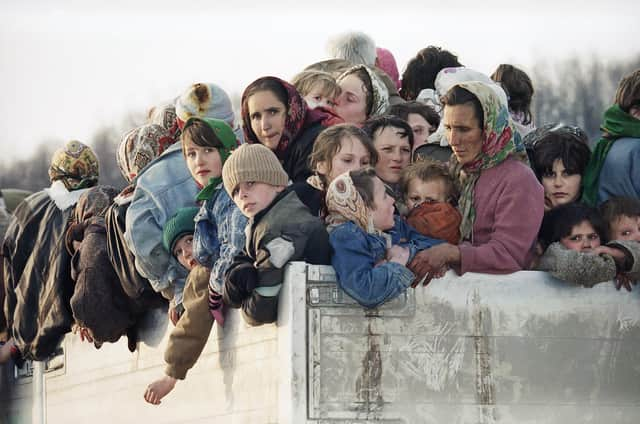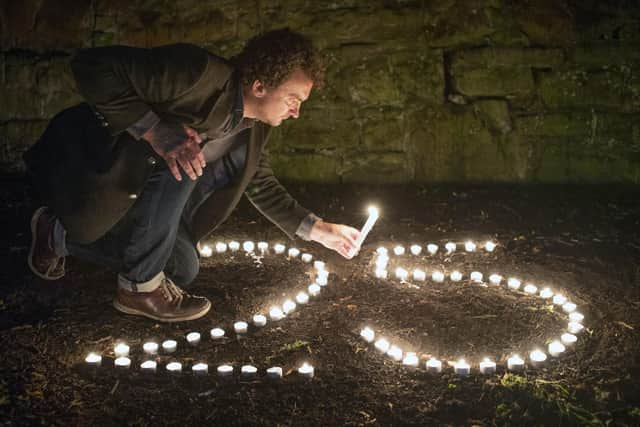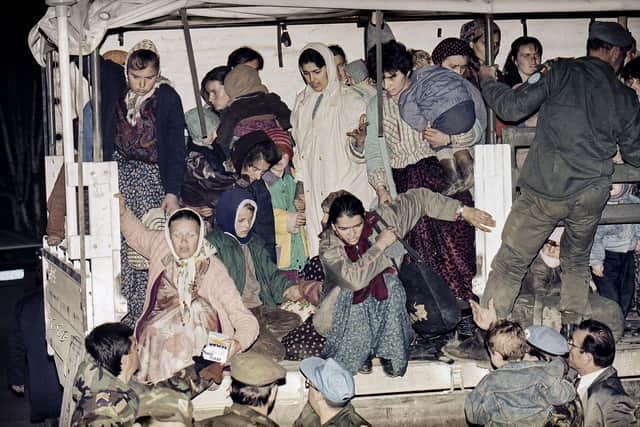What the horrors of Srebrenica can teach Scotland 25 years on


The horrors, the losses and the hauntings of the Massacre of Srebrenica are being brought home to Scotland 25 years on.
The killing of more than 8,000 Muslim Bosniak men and boys close to the Bosnian Serb border on July 11, 1995, may to many remain a distant event in the long-raging war in the Balkans but its legacy is immediate and a powerful message for now
Advertisement
Hide AdAdvertisement
Hide AdThe killing of more than 8,000 Muslim Bosniak men and boys close to the Bosnian Serb border on July 11, 1995, may remain to many a distant event in the long-raging war in the Balkans but its legacy is immediate and offers a powerful message for now.


Today, the anniversary is being used, not only to highlight the atrocity itself, but also to spread the broader warning on what can happen when hate rises and divides.
Srebrenica, an old salt mining and spa town, bore witness to the worst atrocity in Europe since the Second World War when Bosnian Serb army units went on the attack.
General Ratko Mladic attempted to bring the heavily disputed region, where nearly three quarters of the population were Muslim, under Serb Orthodox control.


An area where people had lived in relative harmony, in a country where its capital Sarajevo hosted the Winter Olympics 11 years earlier and brought Torvill and Dean's Bolero gold to the world, was now home to genocide.
Very Reverend Dr Lorna Hood, former Moderator of the Church of Scotland, the chair of Remembering Srebrenica Scotland, who has led several delegations to the area, said: "What has caught us all is that all these people had lived together, they had worked together, they had celebrated each other's festivals. Each village had a mosque and a church, people lived side by side.
“There was a feeling that if this could happen in Srebenica, this could happen anywhere.”
Targets included those who had gathered at a poorly -defended UN safe zone, guarded by Dutch forces, which was set up an old battery factory in the nearby village of Potočari.
Advertisement
Hide AdAdvertisement
Hide AdSeparated from their wives and children who were placed on buses, thousands of men were killed as they ran for days and nights through the surrounding forests and hills in search of safety.
Their bodies were dumped in mass graves and then later excavated, their skeletons split up and scattered around the countryside. The remains of more than 1,000 victims have never been found. Families continue to search for truth, for justice and heartbreakingly the remains of their loved ones.
Dr Hood said there was still much ignorance about what happened in Srebrenica.
She added: “If you asked anyone on the delegations, they would all say ‘we knew something had happened, but not the extent of what happened’.
“There is a great deal of ignorance. Here was a country, not far from us, and we didn’t really realise that the worst atrocity since World War Two had taken place.”
Dr Hood said that back in 1995 as thousands were killed, she was “getting on with life, getting on with work and my children " as tragedy unfolded.
But, she added: “It is when you go out there, meet with survivors, meet people who are still fighting for justice, meet people who are still searching for loved ones, that it hits you.”
Remembering Srebrenica Scotland was set up in 2015 to spread awareness about the massacre, its causes, its impact and legacy with those who travel with the charity obliged to share stories and information about what happened there.
Advertisement
Hide AdAdvertisement
Hide AdFirst Minister Nicola Sturgeon has been among delegates who met survivors as well as bereaved families who continue to fight to preserve the memories of their loved ones.
She said: “The pain and suffering they have endured is unimaginable but their determination and perseverance to carry on and create a better world, free from injustice and brutality, is nothing short of remarkable.
“Atrocities like the Srebrenica genocide do not occur overnight. When hatred and bigotry are allowed to seep into any part of society we are all at risk of a less peaceful and tolerant world.
“Although 25 years have passed since more than 8,000 men and boys had their lives taken from them – and many women and girls suffered appalling crimes of sexual violence - it is still vital that we remember and reflect on one of Europe’s darkest chapters.
“The Srebrenica genocide must never be forgotten and we must never allow the prejudice and intolerance that led to such brutality to infiltrate our society ever again.”
Commemorations in Scotland on the 25th anniversary of the massacre have moved online amid lockdown.
A service planned for the main hall at Kelvingrove Art Gallery and Museum was to feature the lighting of 11 candles to reflect the date. Part of the museum was to be given over to an exhibition of items loaned by museums in Sarajevo with a new work by artist Peter Howson, who was appointed official British war artist for Bosnia in 1993, was due to be unveiled.
Mr Howson said late last year that it was “difficult to put into words” the horror of the massacre at Srebrenica, where he witnessed “what I can only describe as hell on earth”.
Advertisement
Hide AdAdvertisement
Hide AdHe added: “The experience caused me many years of illness and the breakup of my family. I still have memories too painful to talk about, but I find that painting these terrible events helps me to try and understand why we do such evil things to each other. This painting records a moment in European history; a memory in my mind’s eye of what happened that day.”
Artist Iain Campbell travelled to Srebrenica last November to paint a number of survivors of the atrocity, including Hasan Hasanović whose twin brother died as they tried to escape through the forest. Hasan survived only on tiny sips of sugar and water. Mr Campbell said he would never forget the “haunted” look in his subject’s eyes.
The artist, who lives in Govan, said he wanted to work with Remembering Srebrenica Scotland following an outbreak of Sectarian violence close to his home last year.
He said: “It’s not simply about remembering what happened 25 years ago, but helping people understand where hate leads us today.
"Last August in Govan we had sectarian riots. I have lived in the West of Scotland all my life, I am used to sectarianism and sectarian parades, but I have never seen anything like that in my life before. I became very conscious about there being a more dangerous edge to what is going on in our own communities.”
Among those he has painted is Kadefa Rizvanović of the Mothers of Srebrenica Association, whose husband disappeared after fleeing on July 11, 1995. She never saw him again.
His body was found 18 years later and laid to rest at the Srebrenica Memorial Centre, which was built at the the old battery factory where so many were killed.
The remains of more than 7,000 men and boys are buried there.
Advertisement
Hide AdAdvertisement
Hide AdAnother of Mr Campbell’s paintings is of Dr. Dragana Vučetić, Senior Forensic Pathologist for the International Commission on Missing Persons, who has helped identify almost 90 percent of those who vanished.
Identified bodies frequently arrive at the Srebrenica Memorial Centre as breakthroughs in identification are made against the odds. Nine were buried there earlier this week as, piece by piece, the truth of Srebrenica is painfully found.
A message from the Editor:Thank you for reading this story on our website. While I have your attention, I also have an important request to make of you.With the coronavirus lockdown having a major impact on many of our advertisers - and consequently the revenue we receive - we are more reliant than ever on you taking out a digital subscription.Subscribe to scotsman.com and enjoy unlimited access to Scottish news and information online and on our app. With a digital subscription, you can read more than 5 articles, see fewer ads, enjoy faster load times, and get access to exclusive newsletters and content. Visit https://www.scotsman.com/subscriptions now to sign up.
Our journalism costs money and we rely on advertising, print and digital revenues to help to support them. By supporting us, we are able to support you in providing trusted, fact-checked content for this website.
Joy Yates
Editorial Director